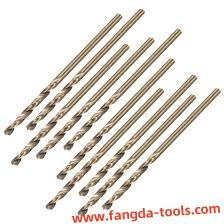Every element of industrial craftsmanship begins with one principle: control. In the creation of each HSS Twist Drill Bit crafted by Fangda, control defines both the process and the purpose. The journey starts not in the final cut but within the material itself—a disciplined fusion of alloy composition, geometry, and mechanical vision. Each twist, each curve in the bit's structure represents years of metallurgical understanding. High-speed steel, chosen for its balance of hardness and flexibility, serves as the foundation. It must endure rapid rotation, friction, and fluctuating temperatures while maintaining accuracy within microns. For that, every decision—chemical, thermal, and structural—must align with mathematical precision.
The forging of an HSS bit begins with alloy refinement. Elements such as tungsten, molybdenum, and cobalt are introduced to grant strength and thermal resistance. The mixture is melted, solidified, and reshaped under strict temperature control, forming a metal that remembers its intended function. This stage is less about shaping metal and more about designing endurance. Once cooled, the material undergoes mechanical transformation. CNC machining carves the geometry that defines the cutting edge. Spiral grooves are engineered not for aesthetics but for fluid motion—channels that guide debris, manage torque, and distribute heat evenly. The curvature of the flute, the depth of the helix, and the symmetry of the point are all tuned for efficiency under rotational load.
However, geometry alone cannot ensure reliability. The surface of a drill interacts constantly with friction, heat, and resistance. Without micro-level protection, even the finest design will surrender to fatigue. This is where surface treatment takes over: coatings such as titanium nitride or oxide layers act as invisible shields. They reduce wear, enhance hardness, and minimize friction-induced temperature rise. Through this, cutting becomes smoother, energy loss decreases, and tool life extends.
Material treatment is followed by one of the most delicate stages—balancing. Each drill is measured for micro-deviation, ensuring that its centerline remains perfectly aligned with rotational symmetry. Any offset, even at a fraction of a millimeter, can translate into vibration, affecting hole precision and surface smoothness. This balancing act is a silent promise to the user: every rotation will echo uniform performance.
The transition from material to motion is where the true craftsmanship emerges. During high-speed operation, the bit faces tremendous stress—centrifugal force, compression, and torsion all acting simultaneously. Yet it remains composed, its molecular structure absorbing and redistributing these forces in harmony. This equilibrium is the essence of engineering beauty: strength without brittleness, speed without instability. In industrial production, reliability means more than endurance—it means predictability. Machines that operate at full cycle efficiency depend on tools that behave consistently. When a drill bit retains its sharpness across hundreds of workpieces, operators gain confidence not only in the tool but in the entire system. Production flow becomes synchronized, waste is minimized, and every finished component carries the signature of controlled perfection.
This commitment to precision is not limited to design but extends to verification. Every batch of drills undergoes dimensional analysis, hardness testing, and torque performance evaluation. Measurements are compared against international standards to ensure global compatibility. The result is a tool that does not merely fit into systems but enhances them. The philosophy behind this is simple: tools should not demand adaptation—they should enable it. By aligning metallurgical science with industrial rhythm, It transforms the humble drill bit into a component of mechanical intelligence. It listens to the material, responds to pressure, and maintains precision through thousands of revolutions.
At its core, this balance between material strength and mechanical grace defines modern industry. Every rotation carries within it a story of design foresight, metallurgical mastery, and relentless pursuit of efficiency.From the first alloy poured to the final edge polished, Fangda HSS Twist Drill Bit represents not only a tool but a philosophy of precision engineered through patience and purpose. Experience its discipline in motion at https://www.fangda-tools.com/product/hss-straight-shank-twist-drill/



